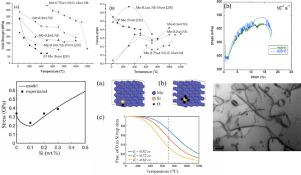Acta Materialia ( IF 8.3 ) Pub Date : 2021-01-19 , DOI: 10.1016/j.actamat.2021.116654 Xiang Yu , Zhi Li , Padam Jain , Huajian Gao , Sharvan Kumar

|
Recrystallized binary Mo-0.2 wt.% Si (Mo-0.68 at.% Si) and Mo-0.3 wt.% Si (Mo-1.0 at.% Si) alloys and a ternary Mo-0.75 wt.% Si-0.14 wt.% B (Mo-2.5 at.% Si-1.2 at.% B) alloy were tested in uniaxial tension as a function of temperature in vacuum and the results are compared to previous results on recrystallized commercial purity (CP) Mo and a binary Mo-0.1 wt.% Si (Mo-0.34 at.% Si) solid solution alloy. Yield strength increases with increasing Si content at all temperatures examined except at room temperature where the 0.1 wt.% Si alloy demonstrates softening; atomistic simulation confirms this behavior to be associated with Si segregation to the core and the associated ease of kink nucleation. Tensile ductility at room temperature rapidly deteriorates with increasing Si content in solid solution but in the Mo-0.3 wt.% Si solid solution alloy, tensile ductility of ~10% was measured at 300°C and thereafter, it increases rapidly at higher temperatures. Serrated flow occurs in the temperature range 600°C~800°C with the serration amplitude increasing with increasing Si content; atomistic simulation illustrates O trapping by Si in solid solution and subsequent de-trapping/release at higher temperatures that can account for the onset temperature delay of serrated flow in these Mo-Si solid solution alloys relative to commercial purity Mo. The serrated flow phenomenon is accompanied by significant work hardening; the presence of dislocation tangles, dipoles and prismatic loops in specimens fractured above ≥ 700°C accounts for the observed work hardening.
中文翻译:

Si含量对Mo-Si固溶合金单轴拉伸行为的影响
重结晶的二元Mo-0.2 wt。%Si(Mo-0.68 at。%Si)和Mo-0.3 wt。%Si(Mo-1.0 at。%Si)合金以及Mo-0.75 wt。%Si-0.14 wt。 %B(Mo-2.5 at。%Si-1.2 at。B)合金在真空中随温度的变化在单轴张力下进行测试,并将结果与先前关于重结晶的商业纯度(CP)Mo和二元Mo的结果进行比较-0.1重量%的Si(Mo-0.34at。%的Si)固溶体合金。在所有检查的温度下,屈服强度都随着Si含量的增加而增加,除了室温下0.1 wt。%的Si合金表现出软化;原子模拟证实该行为与硅偏析到芯部以及相关的扭结成核容易程度有关。室温下的拉伸延展性随着固溶体中Si含量的增加而迅速降低,但在Mo-0.3 wt。%Si固溶体合金中,在300°C时测得的拉伸延展性约为10%,此后在较高温度下迅速增加。锯齿状流动发生在600°C〜800°C的温度范围内,锯齿状振幅随Si含量的增加而增加;原子模拟表明,固溶硅中的O会俘获O,然后在较高的温度下进行去俘获/释放,这可以解释这些Mo-Si固溶体合金中锯齿状流相对于商业纯度Mo的锯齿状流动的起始温度延迟。伴随着重大的工作硬化;在高于700°C的温度下断裂的试样中存在位错缠结,偶极子和棱形环,这说明观察到的加工硬化。锯齿状流动发生在600°C〜800°C的温度范围内,锯齿状振幅随Si含量的增加而增加;原子模拟表明,固溶硅中的O会俘获O,然后在较高的温度下进行去俘获/释放,这可以解释这些Mo-Si固溶体合金中锯齿状流相对于商业纯度Mo的锯齿状流动的起始温度延迟。伴随着重大的工作硬化;在高于700°C的温度下断裂的试样中存在位错缠结,偶极子和棱形环,这说明观察到的加工硬化。锯齿状流动发生在600°C〜800°C的温度范围内,锯齿状振幅随Si含量的增加而增加;原子模拟表明,固溶硅中的O会捕集O,然后在较高的温度下进行去捕集/释放,这可以解释这些Mo-Si固溶体合金中锯齿状流相对于商业纯度Mo的锯齿状流动的起始温度延迟。伴随着重大的工作硬化;在高于700°C的温度下断裂的试样中存在位错缠结,偶极子和棱形环,这说明观察到的加工硬化。原子模拟表明,固溶硅中的O会俘获O,然后在较高的温度下进行去俘获/释放,这可以解释这些Mo-Si固溶体合金中锯齿状流相对于商业纯度Mo的锯齿状流动的起始温度延迟。伴随着重大的工作硬化;在高于700°C的温度下断裂的试样中存在位错缠结,偶极子和棱形环,这说明观察到的加工硬化。原子模拟表明,固溶硅中的O会俘获O,然后在较高的温度下进行去俘获/释放,这可以解释这些Mo-Si固溶体合金中锯齿状流相对于商业纯度Mo的锯齿状流动的起始温度延迟。伴随着重大的工作硬化;在高于700°C的温度下断裂的试样中存在位错缠结,偶极子和棱柱环,这说明观察到的加工硬化。











































 京公网安备 11010802027423号
京公网安备 11010802027423号